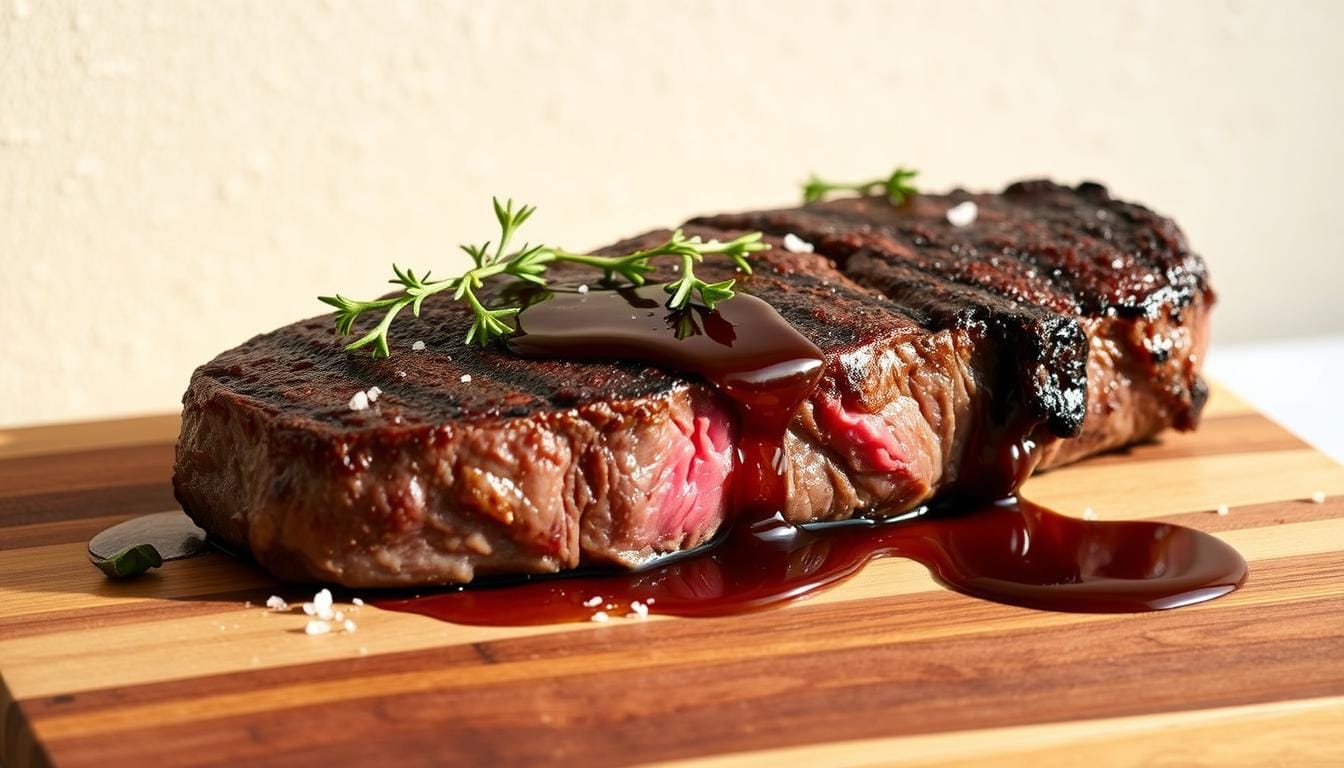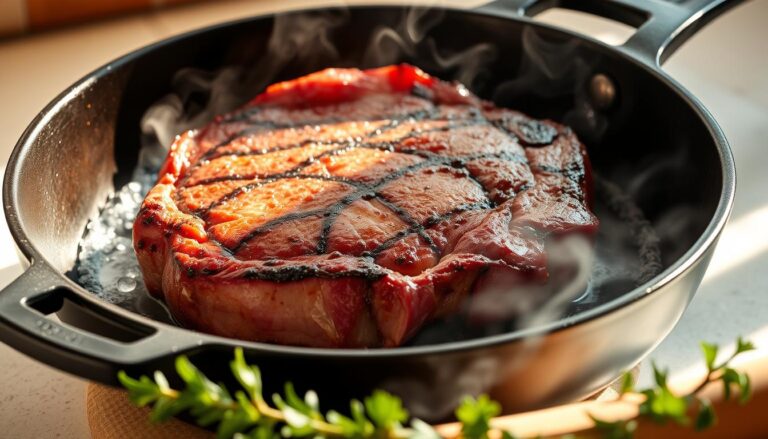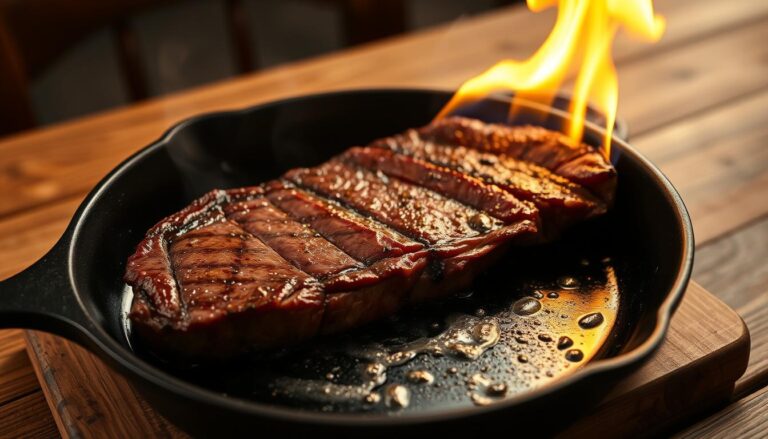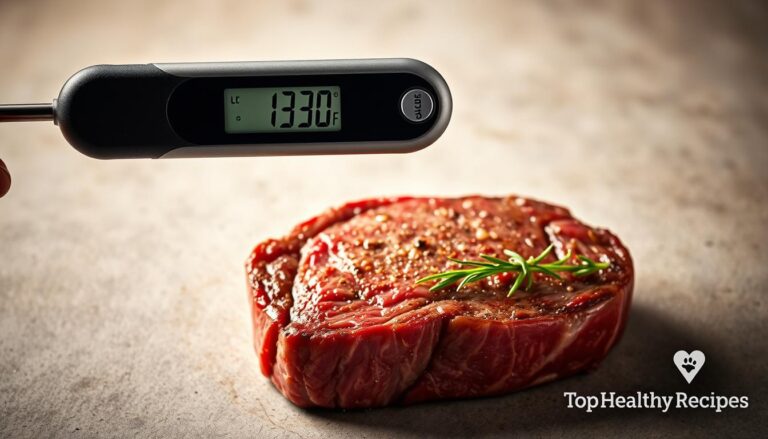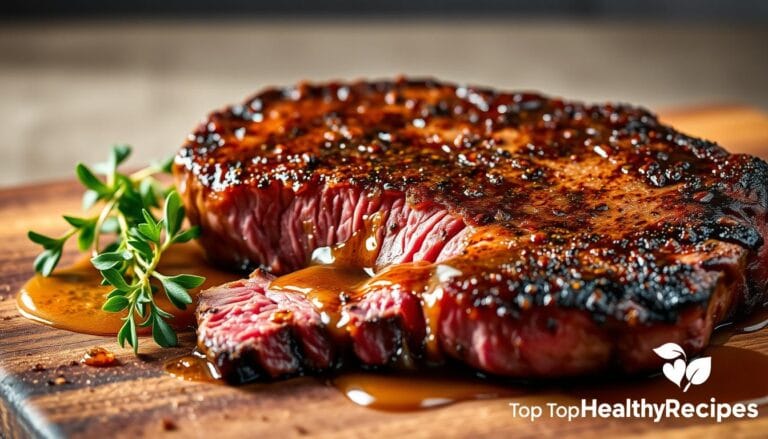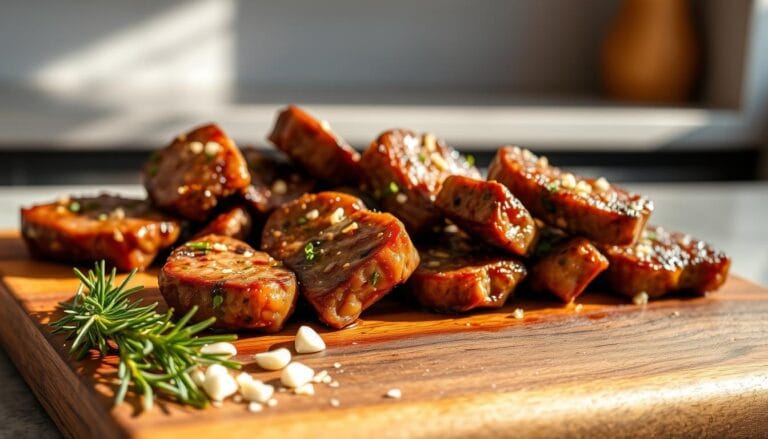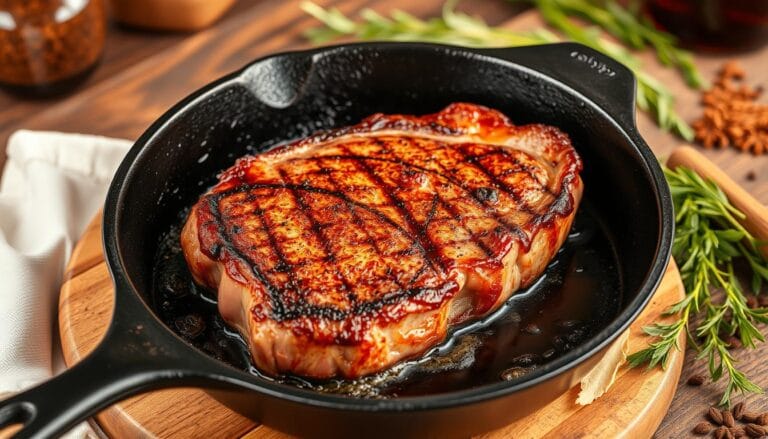How to Cook Coulotte Steak Perfectly Every Time
Table of Contents
How to Cook Coulotte Steak Perfectly Every Time
Imagine slicing into a tender, flavorful coulotte steak, cooked just right and served with your favorite sides. This beef cut, often overlooked but loved by chefs, can change your cooking game. With the right techniques and practice, you can cook a delicious coulotte steak that will wow everyone.
Whether you’re an experienced home cook or new to steak, this guide will help you cook a perfect coulotte steak. You’ll learn how to pick the right cut and serve it well. You’ll get all the tips you need to take your steak game to the next level.
Key Takeaways
- Understand the characteristics of a great coulotte steak
- Learn how to select and prepare the perfect cut
- Discover cooking techniques for a tender and flavorful result
- Explore serving suggestions to complement your steak
- Master the art of cooking coulotte steak with confidence
What is Coulotte Steak?
Coulotte steak, also known as the top sirloin cap, is a triangular cut of beef. It’s gaining popularity for its rich flavor and tender texture. This cut comes from the cap of the top sirloin butt, known for its marbling and rich beefy taste.
Understanding the Cut of Meat
The coulotte steak is separated from the top sirloin and is known by various names, including picanha in Brazilian cuisine. Its unique muscle structure makes it a favorite among steak lovers. The triangular shape and moderate marbling give it tenderness and depth of flavor.
When cooked right, the fat cap on a coulotte steak makes it juicy and flavorful. This is different from other steak cuts that may not have as much marbling or a fat cap.
Flavor Profile of Coulotte Steak
The flavor of a coulotte steak is rich and beefy. It’s more intense than a tenderloin but more refined than chuck cuts. The moderate marbling keeps it tender and juicy when cooked.
When making a coulotte steak recipe, it’s key to use its natural flavors. Simple seasonings can boost its taste without overpowering it. For those who want to try more, advanced spice combinations can add complexity to the dish.
Choosing the Right Coulotte Steak
Finding the perfect coulotte steak starts with picking the right cut. This steak, also known as sirloin coulotte or top sirloin cap, is famous for its tenderness and flavor. Knowing where to look and what to look for is key.
Where to Buy Coulotte Steak
You can find coulotte steak at specialty butcher shops, high-end grocery stores, and online. These places often have high-quality meat and may offer custom cuts. If you’re at a butcher, ask for a custom cut. They can help you choose.
Online retailers also offer a convenient option. They provide detailed descriptions and ship directly to you.
How to Select Quality Meat
Choosing quality coulotte steak means looking at a few things. Look for a bright cherry-red color, which means it’s fresh. The marbling pattern is also important; it makes the steak tender and flavorful.
The fat cap should be even and not too thick. Knowing about USDA grading is also important. Prime, Choice, and Select grades show the quality of the beef, with Prime being the best. Also, think about whether you want grass-fed or grain-finished beef, as each has its own taste.
Choose steaks that are 1-2 inches thick. This thickness ensures even cooking and the right doneness. Freshness is essential, so check the packaging date or ask your butcher.
Think about the size of the steak too. A bigger steak is great for more people, while a smaller one is better for one. Knowing the different labels and names used by stores can also help. For example, it might be called picanha in some places.
Essential Tools for Cooking Coulotte Steak
The secret to a great coulotte steak is in the tools you use. You’ll need the right cookware and gadgets to make cooking easier and more efficient.
Recommended Cookware
There are many types of cookware for cooking coulotte steak, each with its own benefits. Here are some top picks:
- Cast Iron Skillets: These skillets keep heat well, making them perfect for searing steak. They ensure a consistent crust.
- Grill Pans: Grill pans give your steak beautiful grill marks. They work like outdoor grills but on your stovetop.
- Outdoor Grills: Outdoor grills, whether gas or charcoal, are great for cooking steak. Gas grills offer steady heat, while charcoal adds smoky flavor.
- Broiler Pans: Broiler pans under the broiler can give your steak a nice crust. It’s a simple way to cook steak in the oven.
| Cookware | Benefits | Ideal For |
|---|---|---|
| Cast Iron Skillet | Even heat distribution, excellent searing | Stovetop cooking, achieving a crust |
| Grill Pan | Grill marks, stovetop grilling | Indoor grilling, pattern on steak |
| Outdoor Grill (Gas/Charcoal) | Smoky flavor, high heat | Outdoor cooking, smoky flavor |
| Broiler Pan | Oven broiling, easy cleanup | Oven cooking, crust formation |
Must-Have Cooking Gadgets
Along with the right cookware, certain gadgets can make cooking better. Here are some essentials:
- Instant-Read Thermometer: It checks the steak’s internal temperature for perfect doneness.
- Leave-In Probe Thermometer: This lets you monitor the steak’s temperature as it cooks.
- Tongs: They help handle the steak without piercing it, keeping the juices in.
- Sharp Knives: Needed for slicing the steak after it’s cooked.
- Timing Devices: They help track cooking time for the right doneness.
Optional gadgets like grill baskets, sous vide equipment, and meat injectors can also be useful for advanced cooking.
Preparing Coulotte Steak for Cooking
Getting your coulotte steak ready is key to a great meal. Knowing how to prepare it is essential for a delicious dish.
Properly Trimming the Steak
Trimming your coulotte steak is a must. It affects how the steak tastes and feels. Some like to keep the fat cap for moisture, while others prefer a leaner steak. Using a sharp knife is key to trimming effectively without removing too much meat.
Also, remove any silver skin to avoid toughness. Make sure the steak is even in thickness for even cooking. For bigger steaks, cut them into smaller pieces for better control.
Marinading Techniques for Enhanced Flavor
Marinating your coulotte steak can really boost its taste. The marinating time can vary from 30 minutes to overnight. It’s important to use a container that covers the steak well and to coat it evenly. Acidic ingredients in marinades, such as vinegar or citrus, help break down the proteins, tenderizing the steak.
Marinades need a balance of acid, oil, and flavor. For coulotte steak, choose a marinade that complements its taste. “A good marinade is like a good conversation; it should enhance the subject, not overshadow it,” as culinary experts often say. Whether to marinate or season depends on the steak’s quality and cooking method.
“The art of cooking is not just about following a recipe; it’s about understanding the ingredients and techniques that bring out the best in them.”
Cooking Methods for Coulotte Steak
Coulotte steak is versatile and can be cooked in many ways. You can grill it for a smoky flavor, pan-sear for a crispy crust, or sous vide for precise doneness. Each method offers a unique taste experience.
Grilling Coulotte Steak
Grilling is a favorite way to cook coulotte steak. It gives a smoky taste and a nice char. Start by heating your grill to high. For gas grills, turn the knobs to the highest setting. For charcoal grills, spread the coals evenly and cover the grill to keep the heat in.
To get great grill marks and avoid flare-ups, set up a dual heat zone on your grill. Sear the steak for 2-3 minutes on each side. Then, move it to a cooler zone to cook to your liking.
| Doneness Level | Grilling Time (minutes) |
|---|---|
| Rare | 4-6 |
| Medium Rare | 6-8 |
| Medium | 8-10 |
Pan-Seared Coulotte Steak
Pan-searing is another great way to cook coulotte steak. It gives a crispy outside and a tender inside. Choose a good pan, like cast-iron or stainless steel, and heat it up.
Put a bit of oil with a high smoke point, like avocado oil, in the pan. Swirl it around. Place the steak in the pan and sear for 2-3 minutes on each side, depending on the steak’s thickness and your desired doneness.
If your steak is thick, finish cooking it in the oven after searing. This method helps cook the inside evenly without burning the outside.
Sous Vide Coulotte Steak
Sous vide cooking is precise and ensures even doneness. To cook coulotte steak sous vide, season the steak first. Then, seal it in a vacuum bag with any extra flavors you like.
Set your sous vide machine to the right temperature for your doneness level. For rare, use 130°F – 135°F; for medium rare, 135°F – 140°F; and so on. Cook the steak for 1-3 hours, depending on its thickness.
After cooking, take the steak out of the bag and dry it. Sear it in a hot pan with a little oil to add texture and flavor. This step makes the steak even more delicious.
Ideal Cooking Temperature for Coulotte Steak
The secret to a great coulotte steak is knowing its perfect internal temperature. It’s not just about how you like it. It’s about bringing out the meat’s natural taste and texture.
Target Internal Temperatures
Getting the internal temperature right is key. The ideal temperature depends on how you like your steak. Here are the temperatures for coulotte steak:
- Rare: 125°F – Red throughout, warm in the center.
- Medium-Rare: 135°F – Pink throughout, hot in the center.
- Medium: 145°F – Slightly pink in the center.
- Medium-Well: 150°F – A hint of pink in the center.
- Well-Done: 160°F – Fully cooked, no pink color.
Coulotte steak is best at medium-rare or medium. Its fat and muscle make it tender and tasty at these temperatures.
Using a Meat Thermometer
A meat thermometer is a must for perfect doneness. There are two types: instant-read and leave-in probe thermometers. Instant-read thermometers give quick readings, while leave-in thermometers monitor continuously.
To use a meat thermometer right, put it in the thickest part of the steak. Avoid fat pockets and bone. Make sure it’s calibrated and clean. Remember, carryover cooking happens after you remove it from heat. It will cook a bit more while resting.
Don’t make common mistakes like not calibrating or not placing it right. These errors can ruin your steak. Follow these tips for a perfectly cooked coulotte steak.
How to Season Coulotte Steak
To get the most out of your coulotte steak, learning to season it is key. Seasoning does more than add flavor; it brings out the meat’s natural taste. Whether you’re a pro in the kitchen or just starting, knowing how to season your steak can elevate your meal.
Simple Seasoning Blends
Begin with simple seasoning blends to explore flavor enhancement. Salt and pepper are a classic choice. Use them just before cooking to enhance the steak’s natural taste. For a richer flavor, try garlic-based seasonings. Mix minced garlic with salt and pepper for a simple yet effective seasoning.
Herbs like rosemary and thyme also complement coulotte steak well. Sprinkle chopped herbs over the steak before cooking for a burst of flavor. Make sure to season evenly so every bite is delicious.
Advanced Spice Combinations
If you’re ready for more complex flavors, try advanced spice combinations. A Latin American-inspired rub with cumin, oregano, and chili powder is a great choice. Or, a Mediterranean blend with herbs de Provence and lemon zest adds a bright, citrusy taste.
When making your own spice rubs, balance the flavors is key. Use 2 parts salt to 1 part other spices. For an Asian twist, add five-spice powder or ginger to your rub. Coat the steak evenly and let it sit for a few minutes before cooking to allow flavors to soak in.
It’s also important to adjust the spiciness or flavor intensity. Taste as you go and adjust the seasoning. The goal is to enhance the steak’s natural flavor, not to overwhelm it.
Resting and Slicing Coulotte Steak
Cooking coulotte steak is more than just the cooking itself. Resting and slicing are key for tenderness and flavor. After cooking, let the steak rest before slicing. This step keeps your steak juicy and tender.
Importance of Resting Meat
Resting your coulotte steak is vital. It lets juices spread evenly, keeping the meat tender and flavorful. When you cook a steak, heat tightens proteins, pushing juices to the surface. Resting allows these proteins to relax, spreading juices throughout the steak.
The right resting time depends on steak thickness. Usually, 5-10 minutes is best. Tenting the steak with foil helps keep heat in and steam out, preserving texture and flavor.
| Steak Thickness | Recommended Resting Time |
|---|---|
| 1 inch | 5 minutes |
| 1.5 inches | 7-8 minutes |
| 2 inches | 10 minutes |
Best Slicing Techniques
After resting, slice your steak correctly. Slicing against the grain makes it tender. Finding the grain direction in coulotte steak can be tricky.
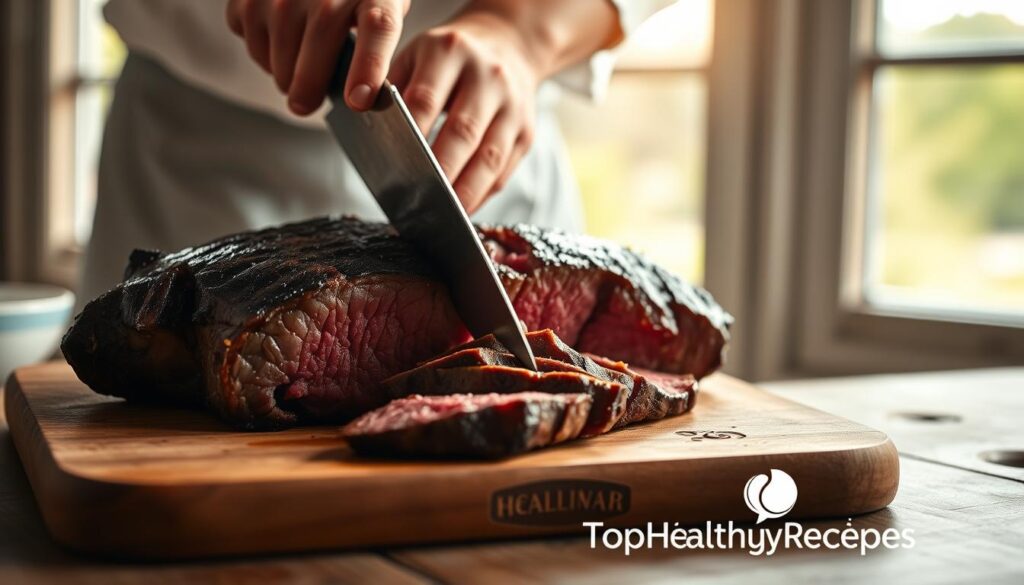
Use a sharp knife to slice the steak, about ¼ to ½ inch thick. The way you slice can also make your steak look great. Try slicing at an angle or arranging slices to show off the steak’s beauty.
By resting and slicing your coulotte steak right, you’ll make your meal better. Whether it’s for yourself or guests, a well-rested and sliced steak will impress everyone.
Pairing Coulotte Steak with Sides
Coulotte steak is versatile and can be paired with many sides. You can choose from classic steakhouse favorites or try new creations. Think about the flavor you want and the textures that go well with the tender sirloin coulotte.
Recommended Side Dishes
Classic steakhouse sides are great with coulotte steak. Roasted potatoes offer a nice texture contrast and taste. Creamed spinach adds luxury with its creamy texture and slight bitterness.
Grilled asparagus is a refreshing choice with its tender crunch and char. It’s a nice contrast to the steak.
For something different, try grain-based sides like farro or quinoa. They add nutrition and flavor. Seasonal vegetables, roasted or sautéed, bring vibrant colors and textures. International sides, like kimchi or salsa verde, add exciting flavors to your coulotte steak recipe.
Suitable Sauces and Condiments
Sauces and condiments can enhance your cooking coulotte steak experience. Chimichurri is a great choice, with its fresh herbs. Compound butters, like garlic or parsley, add richness. Red wine reductions and béarnaise sauce also complement the steak’s flavors.
Choose a sauce based on how you cooked the steak. A pan-seared coulotte steak goes well with red wine reduction. A grilled steak pairs nicely with chimichurri. Try different sauces to find the perfect match for your how to cook coulotte steak dish.
“The right sauce can make or break a steak dinner. It’s all about balance and complementing the natural flavors of the meat.” – Renowned Chef
Storing Leftover Coulotte Steak
To enjoy your coulotte steak for days, learn how to store and reheat leftovers. Proper storage keeps the steak quality high and safe to eat.
Best Storage Practices
After cooking your steak, cool it down fast to stop bacteria growth. Use a shallow metal pan or an ice bath to cool it quickly. Once cooled, put the steak in an airtight container to keep it fresh.
Keep the steak in the fridge at 40°F (4°C) or below. For fridge storage, eat the steak in 3 to 4 days. For longer storage, freeze it. Wrap the steak tightly in plastic or foil and freeze at 0°F (-18°C) or below. Frozen steak stays good for 2 to 3 months.
| Storage Method | Maximum Storage Time | Storage Tips |
|---|---|---|
| Refrigeration | 3-4 days | Store in airtight containers at below 40°F (4°C) |
| Freezing | 2-3 months | Wrap tightly in plastic wrap or aluminum foil and store at 0°F (-18°C) or below |
Reheating Tips
Reheating your steak needs care to keep it tender and flavorful. Oven reheating is a good method. Preheat your oven to 250°F (120°C), place the steak on a wire rack, and reheat until it’s hot.
You can also use a sous vide machine or stovetop with steam for even heating. Before reheating, let the steak come to room temperature for better heating.
For quick reheating, the microwave is an option. But it’s not the best as it can heat unevenly. The fat in coulotte steak helps it reheat well, making it great for leftovers.
Think about using leftover steak in cold dishes like salads or sandwiches. This way, you can enjoy it in different ways without reheating.
Tips for First-Time Cookers
Cooking coulotte steak for the first time can be rewarding. With the right tips, even beginners can make a delicious coulotte steak. Here are some helpful hints to get you started.
Common Mistakes to Avoid
When cooking coulotte steak for the first time, avoid common mistakes. One error is cooking the steak straight from the fridge. Instead, bring the steak to room temperature before cooking for even cooking.
Another mistake is overcrowding the cooking surface. Cook steaks one at a time if needed, to ensure each steak has enough space. Flipping the steak too often can also ruin the crust. Flip the steak only once or twice, depending on your cooking method.
Pressing down on the steak with your spatula can squeeze out juices and make it tough. Resist the urge to press down, and let the steak cook undisturbed. Lastly, avoid cutting into the steak too soon to check for doneness. Instead, use a meat thermometer to check the internal temperature.
Cooking Timelines for Perfect Results
Planning is key to cooking the perfect coulotte steak. Here’s a step-by-step timeline to help you prepare:
- Bringing to room temperature: 30-60 minutes
- Seasoning application: varies by method
- Preheating cooking surfaces: 10-15 minutes
- Cooking time: varies by method and thickness
- Resting period: 5-10 minutes
- Slicing: just before serving
Understanding the total time needed helps you plan your meal preparation. Some steps, like seasoning, can be done in advance. Others, like cooking and slicing, should be done just before serving.
Enhancing Flavor with Marinades
Marinades can change the taste of your coulotte steak. They add flavors that make the steak even better. This makes your meal more enjoyable.
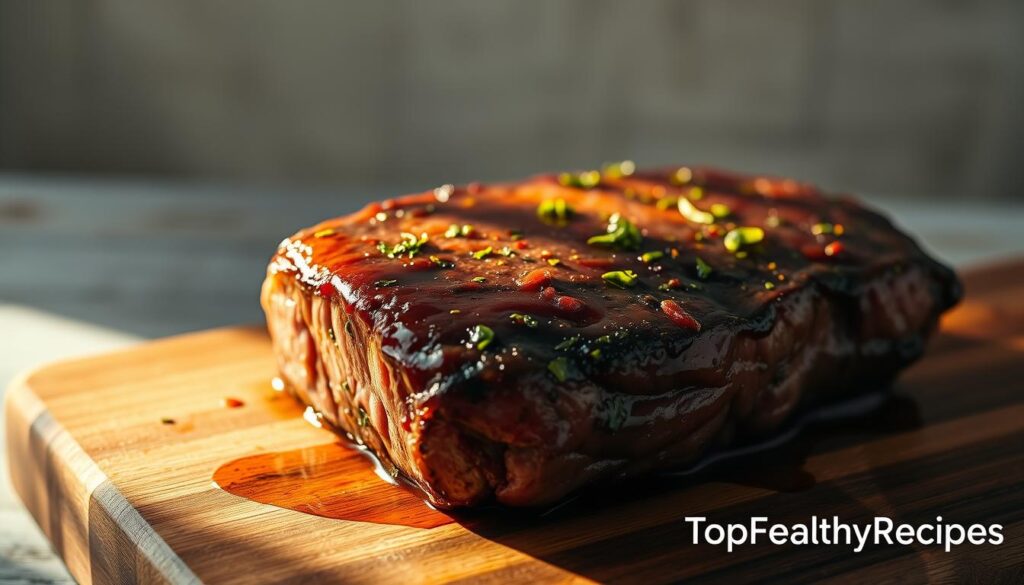
Quick Marinade Recipes
Quick marinades are great for those in a hurry. They add flavor to your steak without needing to tenderize it. This is perfect for high-quality steaks.
- Citrus-Herb Blend: Mix 1/4 cup olive oil, 2 cloves minced garlic, 1 tablespoon freshly squeezed lemon juice, and 1 tablespoon chopped fresh herbs like thyme or rosemary. Marinate for 30 minutes to 2 hours.
- Soy-Ginger Combination: Combine 1/2 cup soy sauce, 1/4 cup olive oil, 2 cloves minced garlic, and 1 tablespoon grated ginger. This marinade works well within 1-2 hours.
- Garlic-Balsamic Mixture: Blend 1/4 cup olive oil, 2 cloves minced garlic, and 2 tablespoons balsamic vinegar. This marinade is effective even within 30 minutes to 1 hour.
Long-Term Marinade Techniques
Long-term marinades give your steak a deeper flavor. You marinate it for 4-24 hours. This lets the flavors soak into the meat.
Use ingredients like pineapple or papaya for enzyme-based marinades. Dairy-based marinades with yogurt or buttermilk work well too. Wine-based marinades add complex flavors.
- Enzyme-Based Marinade: Use 1 cup yogurt or buttermilk, 1 tablespoon lemon juice, and 1 teaspoon chopped fresh herbs. Marinate for 4-8 hours.
- Wine-Based Marinade: Mix 1 cup red or white wine, 1/4 cup olive oil, 2 cloves minced garlic, and 1 tablespoon chopped fresh herbs. Marinate for 8-24 hours.
When using long-term marinades, keep the steak in the fridge. Turn it now and then for even flavor. Don’t marinate too long, or it might taste too salty or acidic.
Serving Coulotte Steak
Serving coulotte steak is an art that needs detail and creativity. Think about how you’ll present it to your guests.
Presentation Ideas
Make the steak look good by slicing it against the grain. Arrange it on a plate in a way that shows its tenderness. Add fresh herbs or paprika for color.
Use a warm plate to keep the steak warm. This helps it stay at the perfect temperature.
For a fancy look, stack the steak on roasted veggies or a salad. This adds to the steak’s flavor and looks great. Don’t forget to drizzle the steak’s juices over it for extra moisture.
Ideal Wine Pairings
Choosing wine for coulotte steak is important. Cabernet Sauvignon and Malbec are great because they match the steak’s rich taste. A full-bodied white or dry rosé can also be good, depending on the seasoning and cooking.
Make sure the wine is at the right temperature. Decanting might be needed. The right wine can make your steak dinner even better.
Steak Doneness and Desired Results
The doneness of a coulotte steak greatly affects its texture, flavor, and enjoyment. Getting the right level of doneness is key for a great meal.
Understanding Different Levels of Doneness
Coulotte steak can be cooked to many levels, from blue rare to well-done. Each level has its own color, texture, temperature, and taste.
- Blue Rare: This steak has a cool red center and is seared outside. It’s cooked to 115°F – 120°F inside.
- Rare: Rare steaks have a warm red center. They’re cooked to 120°F – 130°F inside.
- Medium Rare: This is the best doneness for many, with a pink center. It’s cooked to 130°F – 135°F inside.
- Medium: Medium steaks have a hint of pink in the center. They’re cooked to 140°F – 145°F inside.
- Medium Well: These steaks are slightly firmer and have a hint of pink. They’re cooked to 150°F – 155°F inside.
- Well Done: Well-done steaks are fully cooked, with no pink left. They reach 160°F or higher inside.
How to Adjust Cooking Time
Changing cooking time is key to getting your desired doneness. The method, steak thickness, and starting temperature all matter.
| Cooking Method | Steak Thickness | Rare | Medium Rare | Medium |
|---|---|---|---|---|
| Grilling | 1 inch | 4-5 minutes per side | 5-6 minutes per side | 6-7 minutes per side |
| Pan-Searing | 1 inch | 3-4 minutes per side | 4-5 minutes per side | 5-6 minutes per side |
| Sous Vide | 1 inch | 1-2 hours at 130°F | 1-2 hours at 132°F | 1-2 hours at 140°F |
To get even doneness, use visual cues, touch tests, and a meat thermometer. This helps, even with unevenly thick steaks.
Health Benefits of Coulotte Steak
Coulotte steak is not just tasty; it’s also packed with nutrients. It’s a great pick for those who love meat but also care about their health.
Nutritional Facts
This steak is full of protein, with about 25-30 grams in every 4-ounce serving. It has a mix of good and bad fats, depending on how it’s trimmed and cooked. A 4-ounce serving has around 200-250 calories.
It’s also loaded with B vitamins, iron, and zinc. These nutrients make it a healthy part of your meals.
Compared to other beef, coulotte steak is lean but flavorful. To get the most health benefits, trim the fat and cook it in ways that don’t add extra calories.
Why Choose Coulotte Steak?
So, why choose coulotte steak? It’s cheaper than some premium cuts but just as tasty. It’s also very versatile, working well with many seasonings and sauces.
It’s a good choice for any meal, from a quick dinner to a special event. Plus, choosing it supports sustainable butchery practices. It’s good for high-protein diets and moderate carb plans, adding balance to your meals.
Frequently Asked Questions about Coulotte Steak
You’ve made it to the final step in mastering coulotte steak. Let’s address some common questions and issues you might encounter when cooking this delicious cut of meat.
Common Queries Answered
Coulotte steak, also known as top sirloin cap or picanha, is a flavorful and tender cut. Its price can vary depending on the region and quality, but it’s generally comparable to other premium steak cuts. When cooking coulotte steak, you can expect a moderate level of tenderness, making it a great choice for those looking for a balance between flavor and texture.
Troubleshooting Cooking Issues
If you’re experiencing issues like excessive smoke during cooking, check your grill or pan temperature. For a proper sear, ensure your steak is dry before cooking and that your pan is hot enough. If you’re having trouble achieving even cooking, consider the triangular shape of the coulotte steak and adjust your cooking time.
For a perfect coulotte recipe, remember to let the steak rest before slicing. Don’t hesitate to experiment with different seasoning blends to enhance the sirloin coulotte’s natural flavor.
By following these tips on cooking coulotte steak, you’ll be well on your way to creating a mouth-watering dish that’s sure to impress. Whether you’re grilling or pan-searing, understanding how to cook coulotte steak to your desired level of doneness is key to a perfect dining experience.
FAQ
What is another name for coulotte steak?
How much does coulotte steak cost?
Is coulotte steak tender?
How do I cook coulotte steak?
What is the ideal internal temperature for coulotte steak?
How do I achieve a good sear on coulotte steak?
Can I marinate coulotte steak?
How should I store leftover coulotte steak?
What are some common mistakes to avoid when cooking coulotte steak?
What wine pairs well with coulotte steak?
For more cooking tips, stay connected with us. We also recommend the cookbook Skinnytaste Simple: Easy, Healthy Recipes with 7 Ingredients or Fewer
For more Recipes about Steak ?
Did You try our recipe ?
There are no reviews yet. Be the first one to write one.
